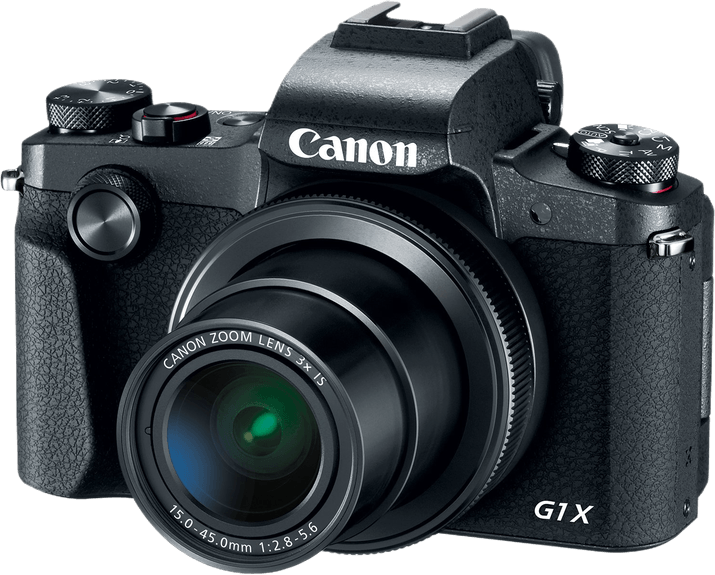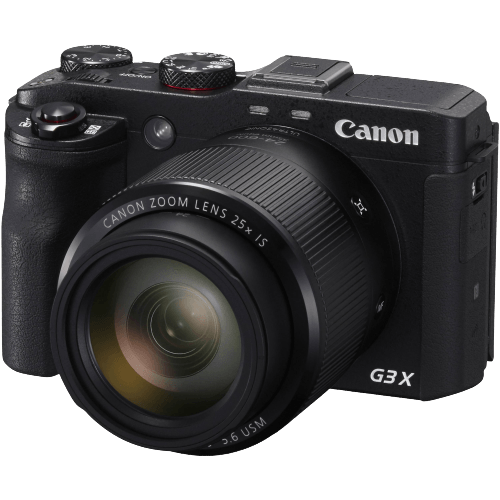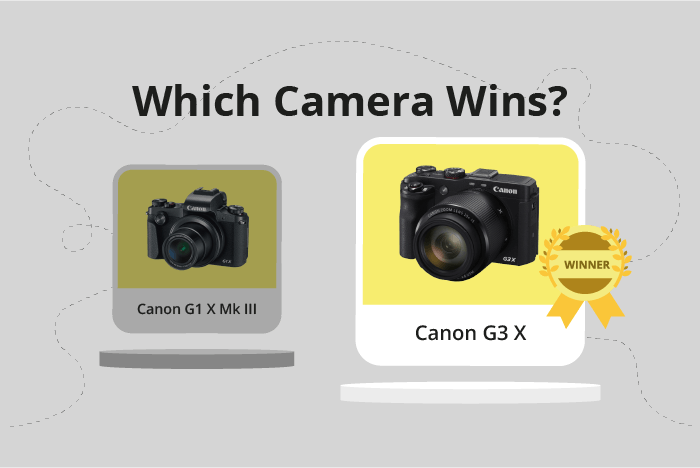Canon PowerShot G1 X Mark III vs PowerShot G3 X Comparison
Canon PowerShot G1 X Mark III

Canon PowerShot G3 X

The Canon PowerShot G1 X Mark III and Canon PowerShot G3 X both have a score of 62/100, making it a tie in terms of overall performance. These bridge cameras share some common specifications, such as their launch prices, with the G1 X Mark III at $1120 and the G3 X at $999. Both cameras were released in the mid-2010s, with the G1 X Mark III in 2016 and the G3 X in 2015.
The G1 X Mark III has a larger size, measuring 138 x 102 x 135mm, and weighs more at 915g (2.02lbs). This could be an advantage for those who prefer a more substantial camera for stability and ergonomics. On the other hand, the G3 X is more compact, with dimensions of 123 x 77 x 105mm, and lighter at 733g (1.62lbs), making it more portable and easier to carry around.
In the end, the choice between these two cameras comes down to personal preference. The G1 X Mark III may be better for those who value a larger, more stable camera, while the G3 X is more suitable for those who prioritize portability and ease of use.
Canon PowerShot G1 X Mark III vs PowerShot G3 X Overview and Optics
The Canon PowerShot G1 X Mark III wins in the optics comparison with a score of 63/100, as opposed to the Canon PowerShot G3 X’s score of 57/100. Both cameras share some common specifications, such as having 20 megapixels, a 1″ CMOS sensor, a fixed lens mount, and image stabilization. However, there are differences that make the G1 X Mark III a better choice in terms of optics.
The G1 X Mark III has a higher shooting speed of 12, which is more than double the G3 X’s shooting speed of 5.9. This means the G1 X Mark III can capture images more quickly, making it suitable for fast-paced photography. Additionally, the G1 X Mark III has a superior Venus Engine processor and a higher DXOMARK sensor score of 71, compared to the G3 X’s DIGIC 6 processor and sensor score of 63. These factors contribute to the G1 X Mark III’s better overall image quality.
On the other hand, the G3 X does not have any specific advantages in terms of optics over the G1 X Mark III. Both cameras share the same megapixel count, sensor size, and image stabilization features. The G3 X’s lower score is a result of its slower shooting speed and lesser processor and sensor performance.
In the end, the Canon PowerShot G1 X Mark III proves to be the better camera in terms of optics due to its faster shooting speed, superior processor, and higher sensor score. The G3 X, while still a good camera, falls short in these areas, making it a less optimal choice for those seeking the best possible optics performance.
Canon PowerShot G1 X Mark III vs PowerShot G3 X Video Performance
The Canon PowerShot G1 X Mark III outperforms the Canon PowerShot G3 X in video capabilities, scoring 83 out of 100 compared to the G3 X’s 70. Both cameras share some common specifications, such as a maximum video frame rate of 60fps and built-in time-lapse functionality.
The G1 X Mark III is superior due to its 4K video resolution and maximum video dimensions of 4096 x 2160. This allows for higher quality, more detailed video capture compared to the G3 X, which only offers Full HD video resolution with maximum dimensions of 1920 x 1080. The higher resolution and dimensions of the G1 X Mark III provide a significant advantage for users who require superior video quality.
On the other hand, the G3 X has the same maximum video frame rate and built-in time-lapse functionality as the G1 X Mark III, which means it is still capable of producing smooth, high-quality footage with creative time-lapse effects. However, its lower video resolution and dimensions make it less suitable for users who prioritize video quality.
In comparing the video capabilities of the Canon PowerShot G1 X Mark III and the Canon PowerShot G3 X, it is clear that the G1 X Mark III is the superior option due to its 4K video resolution and larger video dimensions. While the G3 X shares some features with the G1 X Mark III, its lower video resolution makes it less competitive for those who require the highest quality video capture.
Canon PowerShot G1 X Mark III vs PowerShot G3 X Features and Benefits
The Canon PowerShot G3 X takes the lead in features with a score of 87/100, while the Canon PowerShot G1 X Mark III follows with a score of 70/100. Both cameras share several specifications, including a touchscreen, flip screen, WiFi, and Bluetooth connectivity. Neither camera features GPS functionality.
The Canon PowerShot G3 X stands out with a larger screen size of 3.2 inches compared to the G1 X Mark III’s 3-inch screen. Additionally, the G3 X boasts a higher screen resolution of 1,620,000 dots, providing clearer and sharper image previews than the G1 X Mark III’s 1,040,000 dots.
On the other hand, the Canon PowerShot G1 X Mark III does not surpass the G3 X in any specific feature. However, its slightly smaller screen size might be preferable for users who prioritize compactness and portability in their cameras.
Considering the features of both cameras, the Canon PowerShot G3 X proves to be the superior choice due to its larger screen size and higher screen resolution. The G1 X Mark III, while not offering any notable advantages over the G3 X, may still appeal to users who value a more compact design. Ultimately, the decision between these two cameras should be made based on individual preferences for screen size and camera dimensions.
Canon PowerShot G1 X Mark III vs PowerShot G3 X Storage and Battery
The Canon PowerShot G1 X Mark III outperforms the Canon PowerShot G3 X in storage and battery with a score of 21/100 compared to 16/100. Both cameras have one memory card slot and accept SD, SDHC, and SDXC (UHS-I compatible) cards.
The G1 X Mark III has a longer battery life, providing 350 shots per charge with its DMW-BLC12 battery. In contrast, the G3 X delivers 300 shots using its NB-10L battery. However, neither camera offers USB charging capabilities.
While the G1 X Mark III holds a clear advantage in battery life, the G3 X does not have any superior storage or battery features. The longer battery life of the G1 X Mark III makes it the more reliable choice for extended shooting sessions.
Canon PowerShot G1 X Mark III vs PowerShot G3 X – Our Verdict
Are you still undecided about which camera is right for you? Have a look at these popular comparisons that feature the Canon PowerShot G1 X Mark III or the Canon PowerShot G3 X:
- Canon PowerShot G1 X Mark III vs Sony Cyber-shot DSC-RX100 VII
- Canon PowerShot G1 X Mark III vs PowerShot G7 X Mark III
- Canon EOS R7 vs PowerShot G1 X Mark III
- Canon PowerShot G1 X Mark III vs Sony ZV-E10
- Canon PowerShot G1 X Mark III vs Sony Cyber-shot RX100 VI
- Canon EOS 5D Mark IV vs PowerShot G1 X Mark III

